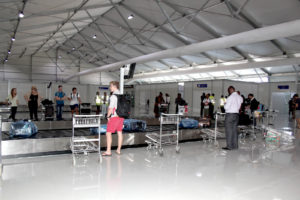 Fabric-roofed structure houses temporary airport terminals in Kenya.
Fabric-roofed structure houses temporary airport terminals in Kenya.
When a fire at Jomo Kenyatta International Airport in Nairobi, Kenya, destroyed the international arrival and departure terminals in August 2013, East Africa’s largest transport hub faced a crisis. With an ever-growing number of domestic and international travelers, airport authorities knew the time required to design and build permanent terminals would be devastating.
They made the decision to house temporary terminals in a semi-permanent facility and turned to HTS/Höcker Clearspan Structures, Kefenrod, Germany, to design a structure that would meet site-specific wind and regional weather requirements for a lifespan of 10 years.
The resulting fabric-roofed semi-permanent structure, completed in June, was fitted with more than 10,000 square meters of Thermo insulated inflatable PVC fabric roof panels manufactured from Mehler block-out material. In addition, the structure features insulated composite sandwich panel wall elements and a combination of external and internal pedestrian access doors, roller shutter doors and glazed panels.
At 40 by 250 meters, with an eave height of 5 meters, the structure was engineered to meet the Kenyan building code, including a wind load requirement of 150 km (about 93 miles) per hour.

“The build schedule was tight and complex from the outset,” says Giles Hill of HTS. “We started with the ground works, which consisted of constructing a load-bearing concrete slab foundation including full integrated installation of waste and freshwater pipework, fire system service pipes, a freshwater reservoir and electric lines. Working with locally sourced contractors, this phase was completed within eight weeks.”
Meanwhile, the structure was designed and fabricated at HTS’s German facility. Installation required an additional eight weeks, with a team of 20 specialists flown in from Germany. Once the main installation was complete, 10 weeks of internal fit-out began. As a turnkey project, HTS was responsible for every aspect, from fire protection and baggage handling systems to security screening stations and toilets.
The fully functional terminal serves 7,000 people per day, enabling the airport to grow in terms of flight and passenger traffic and see it through the extended period of development and building of a permanent facility.
“All in all, the scale and complexity of the project tested our abilities in both design and project management in the sourcing and working in parallel with many specialist product suppliers and trades within a relatively short space of time, all working to achieve the fixed delivery deadlines,” Hill says.
 TEXTILES.ORG
TEXTILES.ORG


